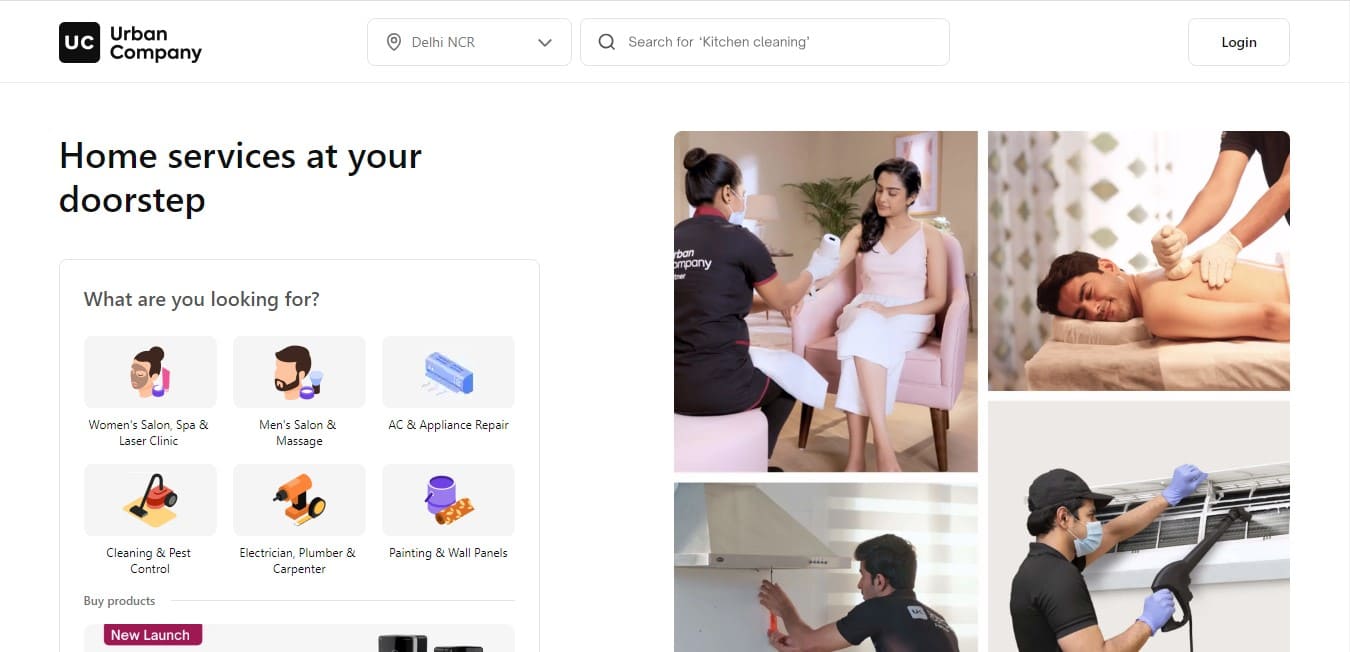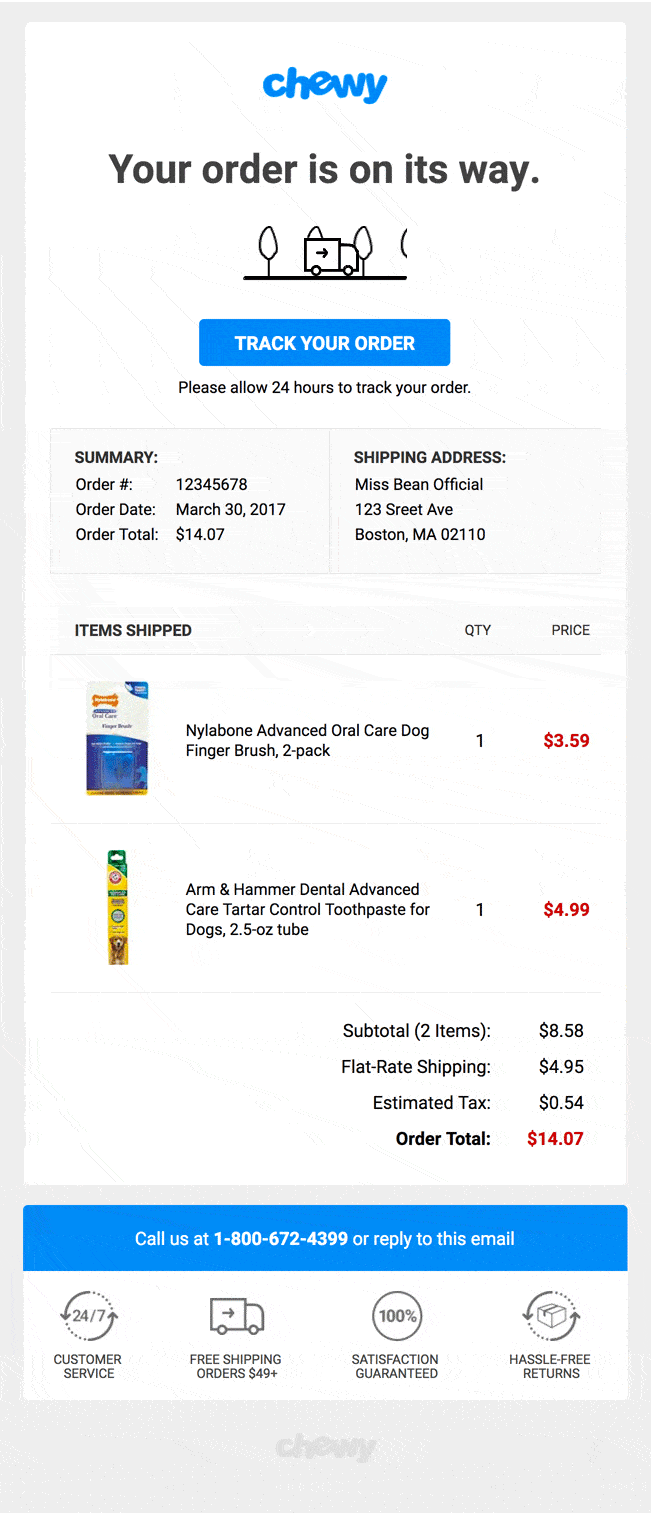By 2026, the global marketing automation market will reach $9.36 billion at a compound annual growth rate (CAGR) of 12.5%. Several businesses already use marketing automation software, reducing marketing costs by as much as 80% while maximizing revenue.
So, if you’re new to marketing automation or want to explore more examples of marketing automation to implement, you’ve come to the right place. It’s important to note that marketing automation goes beyond just email marketing.
However, most marketers tend to focus on email automation alone. To enable you to get the most out of your marketing efforts, I have shared 11 examples of marketing automation that go beyond emails.
Table of Contents
Marketing Automation in a Nutshell
As a marketer, your primary focus is implementing marketing strategies that help you gather new leads and nurture them through the customer journey. Ultimately ensuring they become repeat buyers.
A significant part of this process is intuitive and requires developing new ideas. However, the rest mainly reinforces existing plans. This is where marketing automation comes in. It helps you keep the ball rolling while focusing on more critical aspects of your business.
Marketing automation software streamlines and automates repetitive marketing tasks like sending drip campaigns, lead scoring, or social media management.
91% of marketers have reported that having an automation strategy helps them achieve their business objectives. Additionally, 77% of people who use marketing automation see an increase in lead conversion.
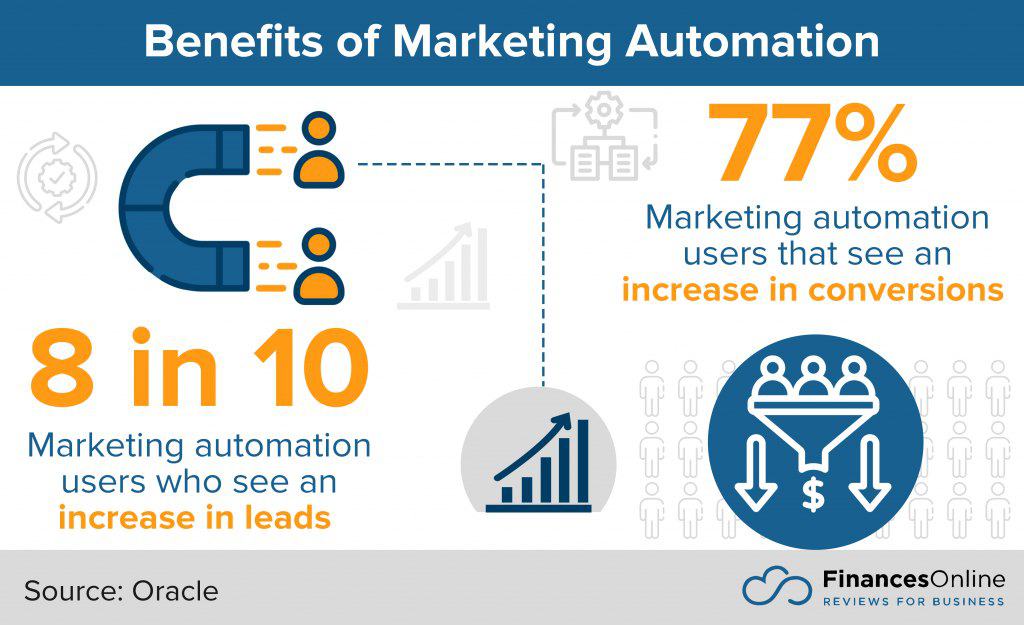
11 Examples of Marketing Automation To Implement Today
There are several automation ideas to implement in your marketing strategy to improve customer experience and engagement and increase your marketing automation ROI. Here are some examples of marketing automation that can help grow your business.
1. Customer onboarding
The process of onboarding new customers or leads, especially when they come from different channels, can be time-consuming. This is where automation becomes instrumental, allowing you to seamlessly onboard each lead.
Onboarding emails help reduce client churn rates because when clients are guided or shown how to make the most of what they have purchased, they are less likely to cancel or abscond.
Here are a few examples of implementing marketing automation in your client onboarding process.
- Set up automated onboarding drip campaigns that deliver tips and educational content over a specific period.
- Make your client onboarding more engaging and rewarding through gamification. That way, you track clients’ milestones and reward them accordingly.
- Send automated welcome emails to new clients when they sign up or purchase a product.
Here’s an excellent example from AirBnB. In this email, AirBnB welcomes their new members. Then, they show users the steps to set up their account before they start exploring home options.
The ‘tell us about yourself’ CTA is an excellent way to get to know their new customers better. This way, they can be added to the right email workflow for more personalized communications. Then, based on their subsequent actions, they will be branched to different email sequences.
Rather than do this the brick-and-mortar way, spending a lot of valuable time and possibly making errors, AirBnB leverages marketing automation to streamline its onboarding process.
Whether you are a B2B, B2C, or SaaS marketer, automating your onboarding process makes your business more engaging and rewarding.
2. Reduce customer wait times with chatbots
Another marketing automation example you need to implement is chatbots.
If your business has a large client base, human interaction with each customer may be impossible and inefficient. So, most companies implement chatbots for effective customer communication.
Chatbots effectively reduce wait times, scale customer support efforts, and automate tasks like appointment scheduling, product recommendations, and processing payments.
Beyond reducing wait times, chatbots are great with lead generation, as 55% of businesses report using chatbots to generate high-quality leads. Additionally, businesses integrate chatbots with their social media platforms to facilitate sales directly without leaving the platform to increase sales and marketing automation ROI.
It doesn’t end there. The data garnered from the interaction with individual clients gives the marketing team more insight into clients’ needs, which helps build more comprehensive customer profiles and optimize marketing efforts.
Sephora is one of the many businesses using this marketing automation example.

This increases their chances of conversion and enables their marketing and sales teams to be more efficient.
3. Lead management for increased sales conversion
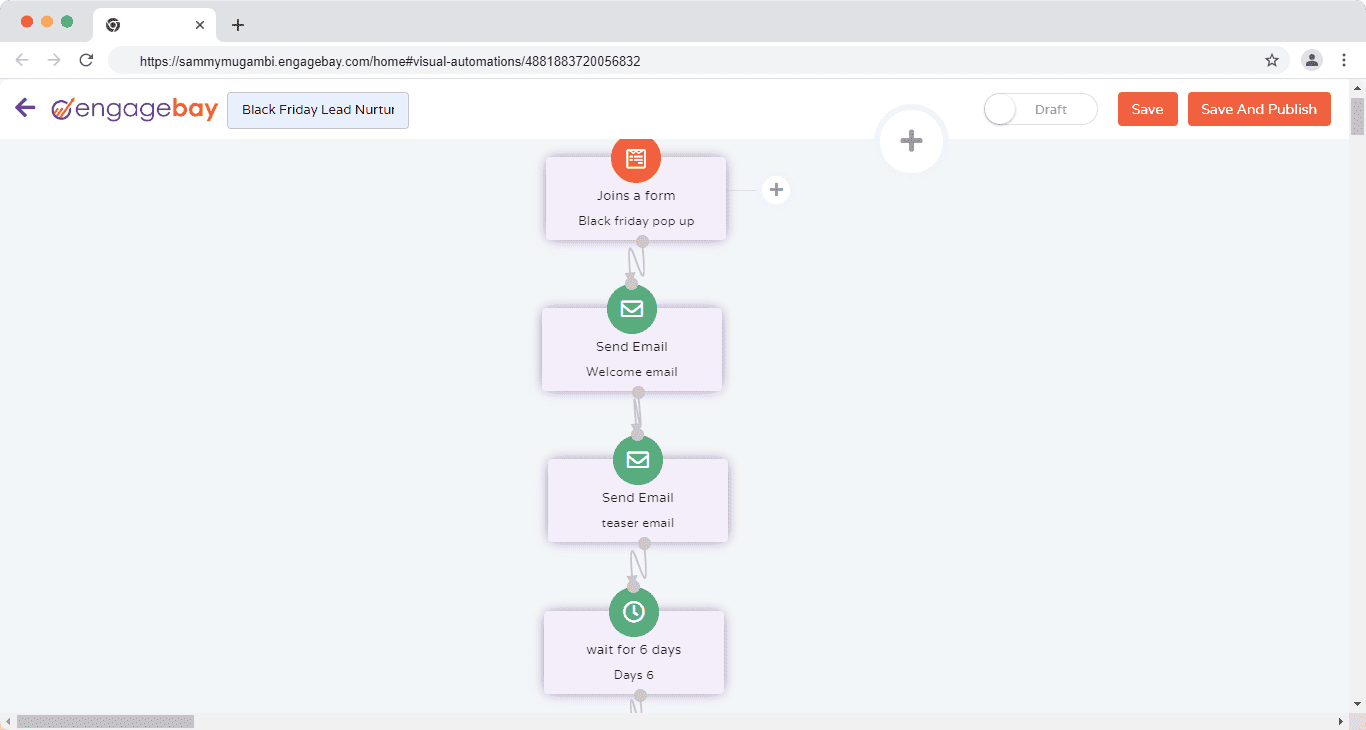
Whether a business-to-business (B2B) or business-to-consumer (B2C), generating and managing leads is crucial to your business’s success.
Generating leads is one thing; managing leads is another ball game entirely, and according to a report, 56% of leads aren’t ready to buy yet, so nurturing them over time is essential.
Lead management is what binds lead generation with sales opportunities by nurturing them from the point of initial contact to conversion. It involves gathering lead information, categorizing them based on similarities, and guiding them through the sales funnel.
Effective lead management doesn’t work in a silo. Marketing automation and CRM tools significantly streamline the process and increase the chances of lead conversion.
CRM software allows you to capture and analyze customer data, giving you a holistic view of lead interactions across multiple teams. You can also score leads, get to know your most qualified leads, and send personalized messaging with marketing automation.
This makes your lead management process more efficient, organized, and streamlined.
Read also: How To Win At Marketing Automation Implementation
4. Client segmentation for personalized communication
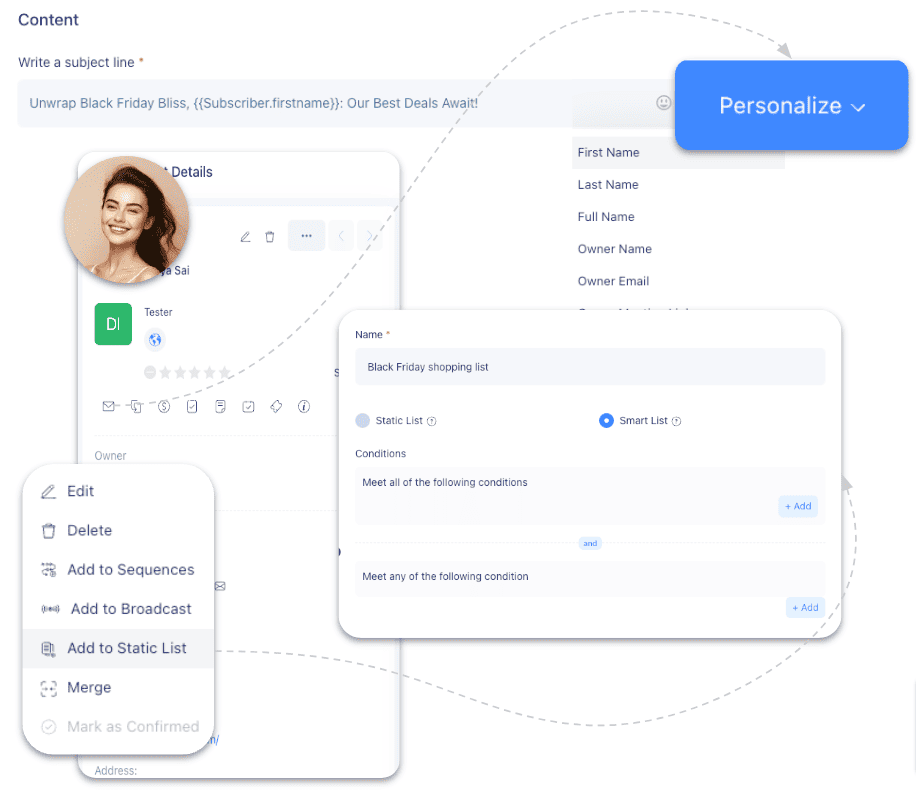
The idea of manually segmenting new leads or even existing customers based on their preferences, interactions, purchase history, or demographics is exhausting.
Proper customer segmentation is a prerequisite for the success of any marketing campaign. A marketing automation tool with a built-in CRM suite is excellent for building advanced segments.
Rather than segmenting clients based on age, demographics, and the like alone. With a 360-degree view of customer behavior and preferences, you can build more precise segments based on the following.
- RFM analysis: Identify high-value clients based on how recently they made a purchase, the frequency of purchase, and the monetary value of their investments.
- Lead score: This allows you to segment leads based on their scores from meeting preset conditions. Higher scores indicate more engaged or sales-qualified leads.
- Client interaction: You get data insights into lead behavior across multiple channels through behavior tracking. For instance, you can see their website views, email engagement, and social media interactions.
- Customer journey: Build precise segments based on clients’ position in your sales funnel.
Additionally, you can combine multiple criteria to create advanced segments. For example, if you are a finance advisor, with marketing automation, you can create a segment of “High-value leads” by combining industry, company position, and website behavior.
Read also: How to Automate Marketing for Unmatched Efficiency
5. Ad automation and personalization
Designing and launching an excellent product is good. But, to make sales, you must put your product out there. You must create and send targeted and personalized ads to get the most out of your marketing campaigns.
Marketing automation makes it possible to send campaigns to target audiences based on factors like their demographics, browsing history, past interactions, or location. For instance, a customer can be shown a product recommendation based on their previous interaction with your brand. This increases the chances of engagement and conversion.
Want to retarget ads? Marketing automation comes in handy for ad retargeting by identifying users who have interacted with your brand but have yet to convert. For example, suppose someone visited your website and abandoned a shopping cart. In that case, marketing automation can trigger retargeting ads on platforms like Google and Facebook to remind them of the products they left behind.
Additionally, you can run ads across multiple platforms to ensure consistency and eliminate the need to manually replicate ads on those platforms.
For instance, rather than launching and monitoring your campaigns across various platforms one by one, with automation software, you can launch and monitor campaign ads on multiple platforms like Facebook, Twitter, Instagram, and LinkedIn.
Beyond launching ads across platforms, marketing automation enables you to schedule and deliver ads at an optimal time.
Urban Company is a leading home service marketplace that adopted ad automation to create ad templates to post on different platforms, leading to an 8x reduction in campaign launch time.
6. Gather client feedback
Gathering customer feedback is integral to your marketing campaign, giving you a direction regarding what you are doing right and what areas need improvement. While this is most commonly done through emails, you can also gather feedback from your website, mobile, and social media channels, depending on which you believe to be more efficient.
For instance, you can send an email requesting reviews or attach a survey link to your social media posts. These reviews can be before or after a customer has made a purchase. Additionally, you can increase the chances of getting more responses by attaching the survey to gated content, such that customers only have access after completing the surveys.
In place of traditional email requests for feedback, Slack employs in-app surveys to solicit product input and monitor user satisfaction in the image above.
In-app surveys are concise feedback forms designed and implemented within the application to collect customer input seamlessly without disrupting the user’s interaction with the product.
This type of marketing automation gets more customer engagement because these surveys are easier to answer and straight to the point.
Read also: How To Build a Killer Marketing Automation Strategy
7. Send transactional emails
Remember when you forgot your password, sent a request to reset your password, and got an email with a link to create a new password? Or when you order a product and get shipping details and subsequent updates on your order status, thanks to transactional emails.
Transactional emails are the lifewire of businesses, especially eCommerce businesses. They contribute to a positive user experience by keeping customers in the loop about their transactions.
These automated emails differ from promotional emails. While promotional emails primarily promote and market products, transactional emails are sent in response to individuals’ actions or purchases.
Sending these emails manually each time a customer takes an action is impossible to do at scale. Marketing automation enables you to send transactional emails at scale. You determine which user actions trigger the email, like order placement, account creation, or appointment scheduling.
Chewy is a leading eCommerce company for pet foods and products. It is one of the many businesses maximizing email marketing automation to build brand trust and customer loyalty.
8. Omnichannel lead nurturing for better marketing ROI
One way businesses nurture leads is through email workflow automation. With email workflows, your subscribers can be automatically added into new sequences or branched off to a different path based on their actions or the conditions they meet.
Beyond emails alone, marketing automation enables you to maximize communication touchpoints across multiple channels. This way, you nurture leads with dynamic content consistent with your brand tone and messaging.
Brands that employ omnichannel marketing see a 9.5% year-on-year increase in revenue.
With automation software like EngageBay, you can create omnichannel lead nurturing campaigns that span emails, social media, and SMS campaigns. That way, from a single platform, you can send and manage campaigns that nurture leads across multiple platforms.
This way, you create a consistent customer experience across all marketing channels.
Additionally, suppose a client abandons their cart on your eCommerce website. Beyond sending a cart abandonment email, you can reach such clients on other platforms like social media or Google with ads retargeting. This increases your communication touch point and, consequently, your chances for conversion.
Read also: Marketing Automation Use Cases & Examples From Top Brands
9. Build customer profiles for targeted marketing
A customer profile is a detailed representation of your existing customers or target audience based on their demographics, key characteristics, behaviors, preferences, and interactions. These profiles are created to understand your target customer base better to improve customer experience and for more effective marketing and sales.
Imagine you’re a SaaS business owner with a diverse customer base. To better understand and cater to your customers, you create customer profiles. You need to track customer behavior across multiple sources, emails, social media, and website visits to segment your customers effectively.
Marketing automation tracks customer behavior. For instance, you can identify high-value customers based on their purchase history and engagement and create personalized content for different customer segments.
CRM software helps centralize customer data, including past purchases, interactions, and preferences. This example from Zendesk Agent Workspace lets you see in-depth customer information such as activity history, ticket information, activity history, and a full conversation history.
10. Drip campaigns
These are automated emails designed to nurture leads over time. Drip campaigns are one of the most common ways businesses employ automation.
Marketing automation facilitates the execution of drip campaigns by delivering emails at the right intervals, automating personalized responses based on user behavior, and enabling segmentation for tailored content.
By using triggers, such as user actions or specific timing, marketing automation ensures that the right message reaches the right recipient at the most opportune moment.
For instance, a SaaS company may want to improve customer retention by designing a drip campaign tailored to re-engage inactive users. When a user’s subscription expires or becomes less active, automation triggers a win-back email.
This drip campaign can begin with an email appreciating the customer’s past subscription and the latest updates and features. If the user doesn’t respond, a follow-up email is sent a week later, offering a limited-time discount or an exclusive feature access to entice their return.
If they engage or renew their subscription, they are transitioned to a different email sequence, receiving onboarding emails or product tips.
11. Marketing analytics
Marketing analytics enables you to analyze business performance over time. Since your business most likely operates a multichannel marketing system, it is instructive to automate marketing analytics.
This means you can seamlessly synchronize data across platforms, including email and websites, and get holistic reports on the business’s performance.
Automating your marketing analytics also helps you track and measure the success of your marketing campaigns while highlighting areas for improvement. Additionally, it lets you assess the success of your marketing campaigns against a wide range of key performance metrics.
Read also: Marketing Automation Use Cases & Examples [101]
Conclusion
Whether you are a startup, a small business, or a large enterprise, there are several examples of marketing automation you can adopt into your marketing strategy, beginning with the 11 shared in this blog post.
With marketing automation as your dedicated assistant, you can implement marketing tasks like nurturing leads, building more precise segments, or automating your eCommerce ads.
EngageBay is an all-in-one CRM, sales, and marketing automation software to streamline your business operation. To begin your automation journey, sign up for our free version or book a free demo with our experts.


